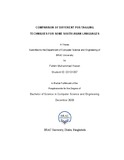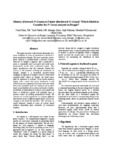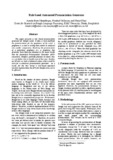Browsing by Author "UzZaman, Naushad"
Now showing items 1-5 of 5
-
Analysis of N-Gram based text categorization for Bangla in a newspaper
Mansur, Munirul; UzZaman, Naushad; Khan, Mumit (BRAC University, 2006)In this paper, we study the outcome of using ngram based algorithm for Bangla text categorization. To analyze the efficiency of this methodology we used one year Prothom-Alo news corpus. Our results show that n-grams of ... -
Comparison of different POS tagging techniques for some South Asian languages
Hasan, Fahim Muhammad (BRAC University, 2006-12)There are different approaches to the problem of assigning a part of speech (POS) tag to each word of a natural language sentence. We present a comparison of the different approaches of POS tagging for the Bangla language ... -
History (Forward N-Gram) or future (Backward N-Gram)? Which model to consider for N-Gram analysis in Bangla?
Khan, Naira; Habib, Md. Tarek; Alam, Md. Jahangir; Rahman, Rajib; UzZaman, Naushad; Khan, Mumit (BRAC University, 2006)This paper presents a directional advantage of n-gram modeling in terms of backward or forward n-gram modeling in Bangla. The most commonly used n-gram analysis is predominantly a forward n-gram. However in Bangla it appears ... -
N-gram based statistical grammar checker for Bangla and English
Alam, Md. Jahangir; UzZaman, Naushad; Khan, Mumit (Center for research on Bangla language processing (CRBLP), BRAC University, 2006)This paper describes a statistical grammar checker, which considers the n-gram based analysis of words and POS tags to decide whether the sentence is grammatically correct or not. We employed this technique for both Bangla ... -
Rule based automated pronunciation generator
Mosaddeque, Ayesha Binte; UzZaman, Naushad; Khan, Mumit (BRAC University, 2006)This paper presents a rule based ronunciation generator for Bangla words. It takes a word and finds the pronunciations for the graphemes of the word. A grapheme is a unit in writing that cannot be analyzed into smaller ...





